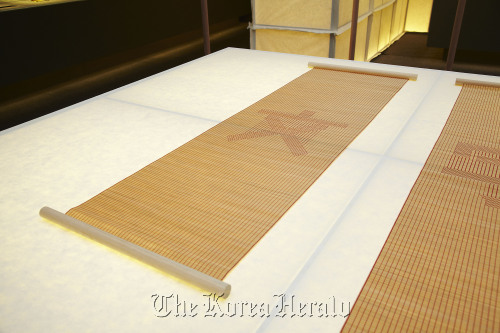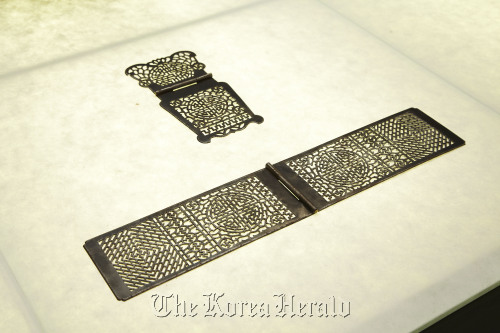
Sulwhasu exhibition brings together handicrafts by 11 Korean masters in various fields
It is impossible to make “hanji,” or Korean traditional mulberry paper, without a hanji screen. And Yu Bae-geun, who is registered as Intangible Cultural Property No. 31, is the sole person in the nation who can make one.
He spends his winters in the freezing Damyang County in South Jeolla Province searching for good four to five-year-old bamboo, and other months indoors extracting the thinnest-possible bamboo ribs. It takes almost a month for the deft artisan to cut the bamboo, boil it in salt water, chip and rub it over and over again until it’s barely 1 mm in diameter. At least several hundreds ribs should be connected to form a screen.
The demand for the screens, of course, has decreased since the import of cheap Chinese ones, Yu told The Korea Herald. They do not, however, have what it takes to create the delicate and soft hanji the right way ― how Korean ancestors did for thousands of years.
Yu is one of the 11 South Korean master craftsmen exhibiting their priceless works, essential for the transmission of Korean traditional culture, at the Sulwhasu exhibition which kicked off last week at beyond museum in Cheongdam-dong, southern Seoul.
The cosmetics brand Sulwhasu has been hosting the exhibition for five years now, and supports the artisans as they create new works. Titled “The Garden of Imaginative Tales,” this year’s show, as usual, offers a precious opportunity for artisans to remind the public of their importance and visitors to learn about a wide range of crafts including pottery, knots, ornamental knives and even salt.
At the entrance of the museum, visitors will encounter a sparkling sea of snow white salt ― at least 2 tons. Named gray salt, it is unusually harvested on mudflats and is known for its outstanding mineral content, flavor and high price.
The man behind it, Park Seong-chun, is one of the nation’s master artisans, said the organizers of the exhibition.
It is impossible to make “hanji,” or Korean traditional mulberry paper, without a hanji screen. And Yu Bae-geun, who is registered as Intangible Cultural Property No. 31, is the sole person in the nation who can make one.
He spends his winters in the freezing Damyang County in South Jeolla Province searching for good four to five-year-old bamboo, and other months indoors extracting the thinnest-possible bamboo ribs. It takes almost a month for the deft artisan to cut the bamboo, boil it in salt water, chip and rub it over and over again until it’s barely 1 mm in diameter. At least several hundreds ribs should be connected to form a screen.
The demand for the screens, of course, has decreased since the import of cheap Chinese ones, Yu told The Korea Herald. They do not, however, have what it takes to create the delicate and soft hanji the right way ― how Korean ancestors did for thousands of years.
Yu is one of the 11 South Korean master craftsmen exhibiting their priceless works, essential for the transmission of Korean traditional culture, at the Sulwhasu exhibition which kicked off last week at beyond museum in Cheongdam-dong, southern Seoul.
The cosmetics brand Sulwhasu has been hosting the exhibition for five years now, and supports the artisans as they create new works. Titled “The Garden of Imaginative Tales,” this year’s show, as usual, offers a precious opportunity for artisans to remind the public of their importance and visitors to learn about a wide range of crafts including pottery, knots, ornamental knives and even salt.
At the entrance of the museum, visitors will encounter a sparkling sea of snow white salt ― at least 2 tons. Named gray salt, it is unusually harvested on mudflats and is known for its outstanding mineral content, flavor and high price.
The man behind it, Park Seong-chun, is one of the nation’s master artisans, said the organizers of the exhibition.

Metal craft artisan Park Moon-yeol’s locks are also sure to catch visitors’ eyes. Not only are the patterns embroidered on the metal exquisite, but the workings of the seven-step lock are amazing. Just as special locks were back in the Joseon Dynasty, it takes seven steps to unlock Park’s locks. Only those with superior knowledge in the structure of the locks are able to open them. Park is designated Intangible Cultural Property No.64.
“This exhibition came as a shock to me. The last time I was in Korea, about 20 years ago, I could not imagine this kind of exhibition in which our traditions and craftworks are so well-organized. Every single one of the exhibits here is something we can all be proud of when displayed anywhere in the world,” said lacquer artist Jun Yong-bok who came back to Korea earlier this year after 24 years in Japan. He is showcasing ocean-inspired lacquer paintings at the show. Contrary to his neat suit and shoes, his fingernails were black from the paint.
The exhibition runs through Nov. 10 at beyond museum in Cheongdam-dong, southern Seoul. Admission is free. For more information, call (02) 794-1559 or visit www.beyondmuseum.com.
By Park Min-young (claire@heraldcorp.com)
-
Articles by Korea Herald








![[Kim Seong-kon] Democracy and the future of South Korea](http://res.heraldm.com/phpwas/restmb_idxmake.php?idx=644&simg=/content/image/2024/04/16/20240416050802_0.jpg&u=)








![[KH Explains] Hyundai's full hybrid edge to pay off amid slow transition to pure EVs](http://res.heraldm.com/phpwas/restmb_idxmake.php?idx=652&simg=/content/image/2024/04/18/20240418050645_0.jpg&u=20240418181020)

![[Today’s K-pop] Zico drops snippet of collaboration with Jennie](http://res.heraldm.com/phpwas/restmb_idxmake.php?idx=642&simg=/content/image/2024/04/18/20240418050702_0.jpg&u=)